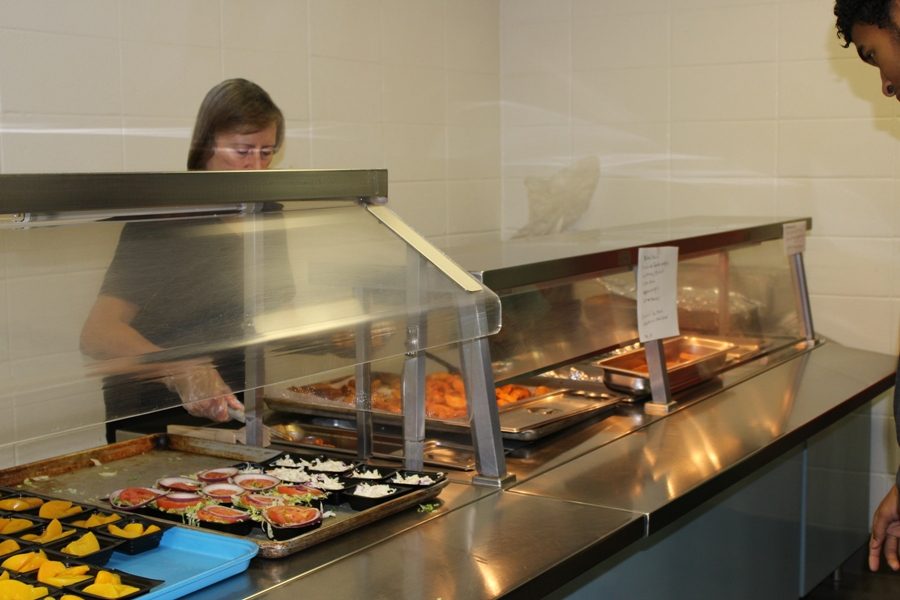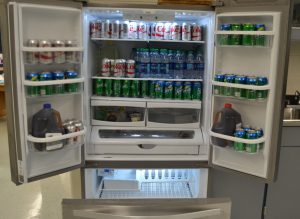Planning key ingredient to student lunch menu
Member of the cafeteria staff serves a Starr’s Mill student lunch. The process to approve the lunch options on the menu take place at the federal, county, and school levels.
November 2, 2016
During the school week, students at the elementary, secondary, and high school levels in Fayette County line up in the cafeteria to select their lunch for the day. What they don’t see is the process behind formulating the menu.
In 1946, The US Department of Agriculture established a National School Lunch Program which is “a federally assisted meal program operating in over 100,000 public and nonprofit private schools and residential child care institutions.”
Public or nonprofit private institutions can take part in the school lunch program. School districts and independent schools that choose to take part in the program receive cash subsidies and food from the USDA for each meal that is served. However, in return, they must serve meals that meet federal guidelines.
These standards are outlined by the Dietary Guidelines for Americans, which requires that, under the 1990 National Nutrition Monitoring and Related Research Act, “every five years the USDA and Health and Human services must jointly publish a report containing nutritional and dietary information and guidelines for the general public.”
The current lunch meal pattern enforces an increase in the intake of fruits and vegetables as well as a specific calorie limit for elementary, secondary, and high school levels. “Students are required to select three components for a meal. The newest requirement is that all students must select a fruit or vegetable. The components are meat/meat alternative, grain, fruit, vegetable, or milk. Students must take a full portion of three. There is also a requirement for vegetable sub groups within a week,” Fayette County School Nutrition Director Kokeeta Wilder said.
At the county level, the menus are created using these USDA requirements for a reimbursable meal, a meal that requires students to choose three full portions of the five, with at least one choice being a fruit or vegetable. “We have a menu planner on staff who develops our menus. She uses data from our schools and feedback from managers on which items are popular and which items should be replaced. We also use surveys and product testing to determine which items would work and which will not,” Wilder said.
Fayette County elementary schools offer three entrees, middle schools offer four and high schools offer five to six. “We usually offer the maximum at all levels. We also try to offer a variety of options so that all students will have choice of entrees. The biggest challenge is space on the serving line,” Wilder said.
Any additions or removals from the menu correlates with the popularity of the item in schools. Menus are typically updated in the Fall and Spring. “The only problem we have with adding new items is availability and estimating the popularity of the item. For example, we recently temporarily removed spaghetti from the elementary school level for the summer and we received request to put the item back on,” Wilder said. “Also, ‘Nacho Wednesday’ and ‘Pizza Friday’ has become a norm for our district. We tried to change it in the past and students were confused when we offered it on a different day of the week. As a result, we changed back because of student preference and popularity.”
Once menus are set, cafeteria staff across the county work to prepare the meals for their students. At Starr’s Mill High School, in order to prepare the food, the 10 ladies who make up the cafeteria staff arrive early to prepare the lunches for both Rising Starr Middle School and The Mill. They can prepare anywhere from 550 to 750 meals a day. “Everyone has their specific duties that they are required to complete to get everything together,” cafeteria manager Maureen Hankey said.
Despite the efforts at the federal and county level to promote a healthier diet among students, Hankey noticed their preferences still lean towards other options. “The most popular selection among students appears to be chicken tenders and nachos,” Hankey said.
To ensure food safety, the Hazard Analysis and Critical Control Point system was developed. This system “requires that potential hazards are identified and controlled at specific points in the process. This includes biological, chemical or physical hazards. Any company involved in the manufacturing, processing or handling of food products can use HACCP to minimize or eliminate food safety hazards in their product.”
The cafeteria staff at the Mill follows the HACCP plan to ensure the safety of the food they serve. “We regularly check the temperature of the food to ensure it is at a safe level throughout the day,” Hankey said.
These guidelines and systems are in place to ensure that students have the options for balanced nutritious meals. There are 14 elementary schools, five middle schools, and five high schools, along with the alternative school and open campus in the county, that all provide safe, balanced, and nutritious options in meals to students. Fayette County is doing its part to promote a healthier diet among the students it serves. “The overall goal would be to provide nutritious meals that are quality and affordable in a friendly environment,” Wilder said.








